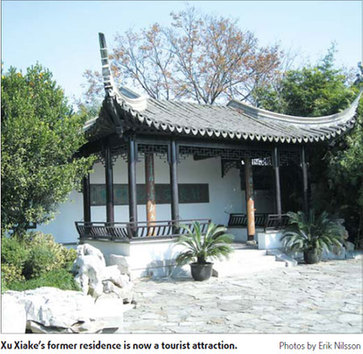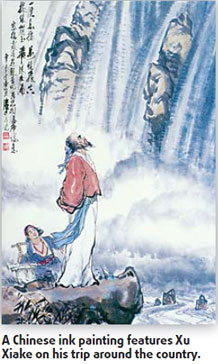|

|
|
Xu Xiake is something like China's real-life Indiana Jones. |
Every year, about 50,000 people flock to the Xu Xiake Memorial in Jiangsu province's Jiangyin county to pay homage to China's most famous traveler-cum-adventurer, who was mysteriously poisoned to death in 1641.
The Chinese travel saint's former residence is today the only national cultural heritage protection site in the county, the strategic position of which meant it was often ravaged by wars, so that few relics survived.
Xu journeyed through 13 of modern China's provinces - Beijing, Hebei, Shandong, Anhui, Henan, Fujian, Hubei, Jiangxi, Hunan, Guangdong, Guangxi, Yunnan and Zhejiang.
He mostly trekked on foot and was robbed three times.
When a monk he was traveling with to Yunnan was murdered in the final heist, Xu carried his ashes and wrote "crossing 72 mountains, 15 hills, 10 caves, 38 wells and 25 rivers" to Jizhushan Temple, according to his diary.
It was his last trip. Unable to walk after he was mysteriously poisoned, he took a boat home, where he died half a year later at the age of 56.
The explorer also conducted the first research on limestone karst formations more than 150 years before the Europeans and traced the Yangtze to what he believed was its source in Jinsha. Although he was several thousand kilometers short of the actual headwaters, he had explored the river further than anyone else.
Xu chronicled his exploits in a diary, which was transformed into the travelogue The Travel Diaries Xu Xiake, first published by his great-grandson in 1776.
The notes from his last expedition were lost when Manchurian forces laid siege to Jiangyin two years after his death. After 81 days of battle, the city was razed to the ground and most of the population slaughtered.
Visitors to his former residence can see three of the original buildings - there were previously seven - which the government purchased from Xu's descendents in 1985. These buildings include the breezeway, sedan chair parking room and guesthouse.
These have been renovated to display educational exhibits about Xu's life. Visitors can see a copy of the last existing specimen of his handwriting and his family tree, which can be traced back to the 12th century. His descendents, nine generations after him and 24 from his first known ancestor, still dwell in Jiangyin.
In addition, visitors can see the Luohan Pine, which Xu is said to have planted about four centuries ago.
His remains and tombstone were relocated in 1978 to what is now the Saint Veneration Garden. The yard was opened in 2001 to honor the 360th anniversary of Xu's death.
Jiangsu gardens typically feature calligraphic works, and the corridor of Saint Veneration Garden features 135 wall hangings printed with excerpts from his travelogue transcribed by celebrated chirographers.
Visitors can also see the building Xu constructed for the 80th birthday of his mother, in which today stands a large stone statue entitled "Xu's Mother Admonishing Her Son". The explorer's mother supported his travels against the Confucian wisdom, which says: "One should not travel too far while one's parents are alive."
The structure seen by guests today has been renovated, as it was burned to a cinder when the Manchurians invaded.
The walls of the Qinshang Hall leading to Xu's tomb are adorned with 76 stone calligraphic works honoring him.
Across from the residence and Saint Veneration Park is the Xu Xiake Tourist Expo Park of China. Opened this September, the park is located on a small peninsula and is shaped like the Chinese character for travel (you).
The park features hundreds of stone calligraphic works, including one of Mao Zedong's famous quotes: "I also want to do as Xu Xiaoke" and a passage from a congratulatory letter from Premier Wen Jiabao honoring the 420th anniversary of Xu's death.
Near the park's entrance, visitors can see the Sheng Shui Bridge, which Xu would cross to depart for his adventures across the country.
The park also features ornamental stones from all of the provinces Xu traversed, a 35-ton stone ink dish, a two-ton stone calligraphy brush and two books totaling 22 tons.
A two-story museum dedicated to Xu is under construction and will open soon.
(China Daily December 19, 2008)